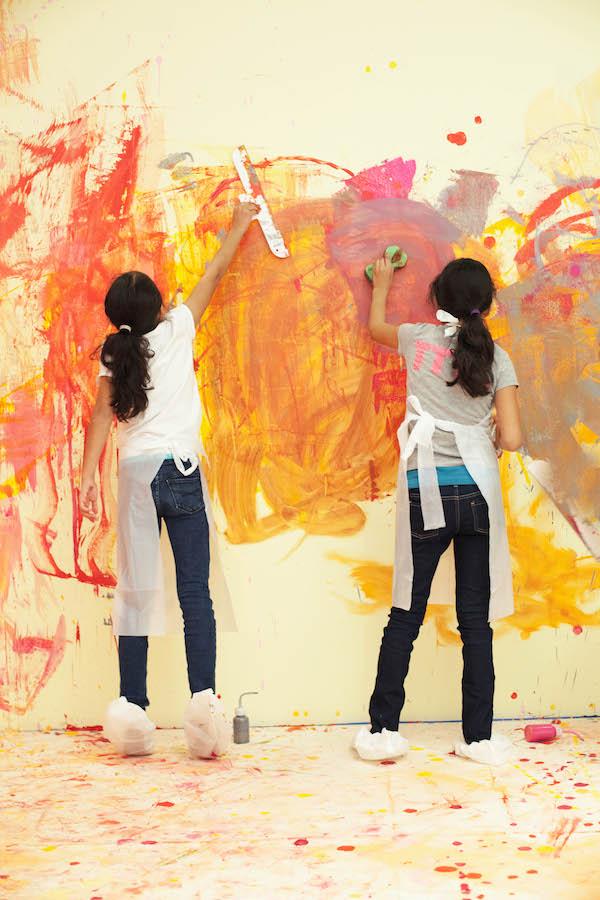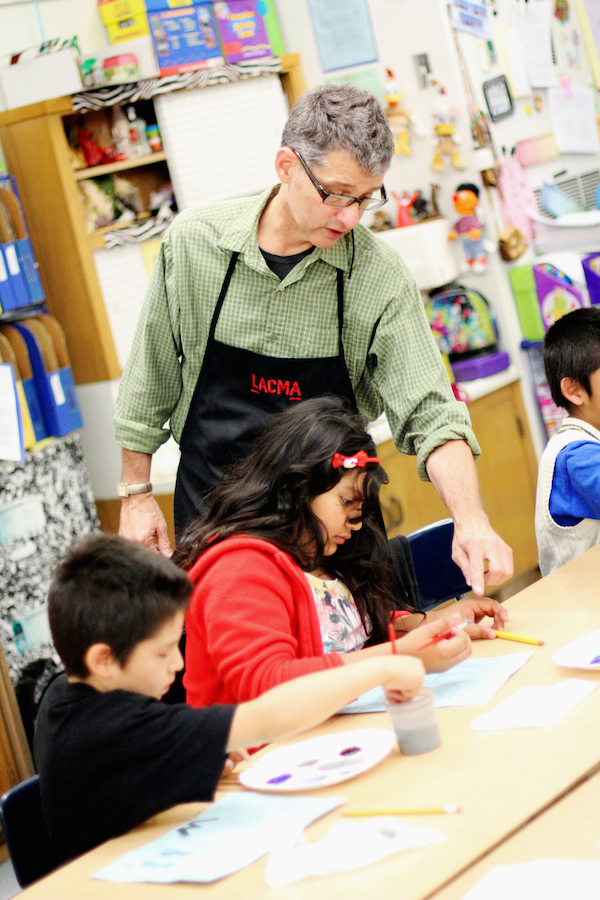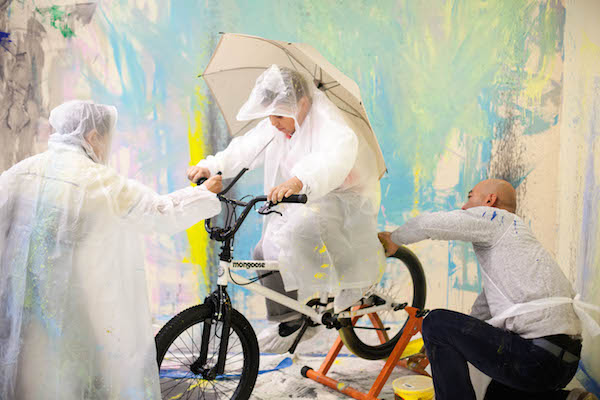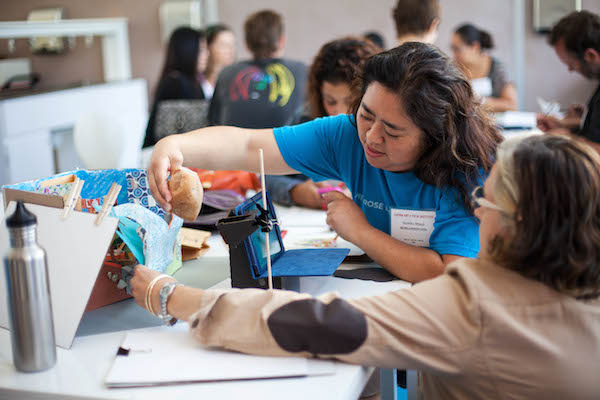Charles White Elementary School, near MacArthur Park, has a unique facility on its campus: an art gallery. Inside that gallery not long ago, Los Angeles artist Kaz Oshiro showed students how various methods and tools make distinguishable marks on their canvas: a squeegee scrapes paint across the surface much differently than a brush; paint squeezed from tubes creates thick glops while the same paint poured through a teapot can be drizzled over the canvas. And how about pedaling a stationary bike over a paint tray? Vivid green paint shoots wildly across the material as a result.
Oshiro was asking the children a fundamental question that all artists, from antiquity to present day, must ask themselves: how will you make your mark? Oshiro’s lesson was part of a larger program facilitated by LACMA in collaboration with the elementary school, in which the museum partners with artists to collaborate with students while curating an exhibition inside the school. It is one of many programs that LACMA’s educators bring to schools throughout Los Angeles County.
Five miles down the road, inside an art studio at LACMA, John Burroughs Middle School art teacher Nancy Hanover tackled the same question as Oshiro, but at an even more practical level: how will you make your mark, and who will put the right tools in your hand? Recently she brought twenty of her students to the museum to participate in an eight-week after-school program, which included gallery tours as well as time in the studio. "The kinds of media we were able to use are beyond what I can offer in the classroom—acrylic paint being one of them," Hanover explains. The program exposes students to the breadth of the museum’s collection, teaches them visual-analysis skills, and gives them a chance to create works of their own. "Without LACMA, there would be very little art taught [in our classroom]," she continues. "It would probably be more craft based, if it was being taught at all."
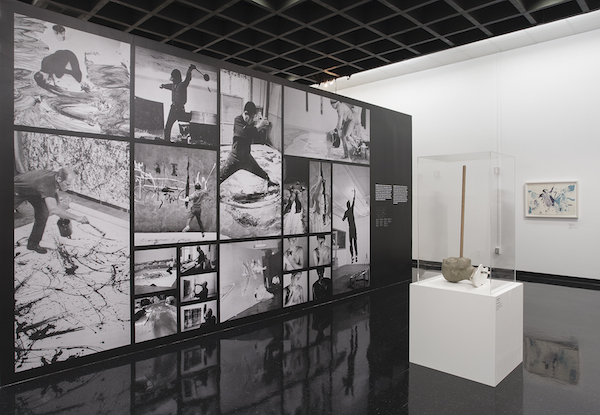
Hanover knows the value of using LACMA as a resource. In addition to After School at the Museum and school tours, she has taken advantage of professional development through Evenings for Educators, and most recently has participated in two new programs that teach kids about the creative possibilities of technology: Through Your Lens, a ten-week after-school filmmaking program taught in the classroom; and Frame x Frame, an animation workshop taught at the museum. "Through Your Lens took me by pleasant surprise," says Hanover. "Today everybody is a photographer; it seems to me that that’s a medium that should be used in teaching students literacy." Working in groups, Hanover’s students devised story lines, determined sequences of events, and then created final projects. The resulting short films ran the gamut: "Some of them were goofy, some of them were about love. One was about war, and one was about feminist points of view from an Arab student, about forced marriage. We had everything from the immature to the sophisticated.” Both programs, Hanover says, were a hit with her students. "Most of them could use the camera without much training at all. It’s their language. Why we’re not providing this to every student is beyond me. If we want to motivate students, this is one really great way to do it."
Hanover is a rare creature in Los Angeles schools—a teacher devoted to art and based full time at one school. Most schools in Los Angeles have long since eliminated full-time art teachers, relying instead on an itinerant teaching program that sees one teacher traveling to as many as ten schools in a week, or shifting responsibility of teaching the arts to educators with no arts background. A 2013 report prepared by the Los Angeles Unified School District noted that only 2% of school time is allotted to the arts in a given week. The same report indicated that the LAUSD has slashed its arts budget by 50% since 2008. Even the itinerant teaching program has been cut from 335 teachers in 2008 to 216 in 2012.
"There are a lot of schools, especially lower-achieving schools, that have closed down their art departments," says Hanover. "A lot of pressure was being put on principals to increase test scores, so they were giving the students an extra math class or language arts class during the time that they would have taken an art class. So [those programs] closed down.” While that is not the case for all schools in Los Angeles, it is the case for a disproportionate amount of schools with lower-income populations, known as Title I schools, where the fight for funding hinges on test scores. “What it means is if you’re underprivileged, you’re underprivileged even more by the fact that the school is not providing these resources to you.”
Jane Burrell, LACMA’s Senior Vice President of Education and Public Programs, has seen the challenges faced by Los Angeles schools over the years. Starting in the 1990s, LACMA altered its approach to arts education, shifting emphasis from adult programming to include more school- and family-oriented initiatives. Generous donors such as Anna Bing Arnold, George and MaryLou Boone, Yvonne Lenart, and Sheila and Wally Weisman were all instrumental in broadening LACMA’s educational scope. Among other strides, free family days at the museum increased from monthly to weekly, and in 1998 the Boone Children’s Gallery was established. Other programs, including internships for high school students and professional-development opportunities for teachers, were also born from this new emphasis on education. LACMA’s acclaimed Arts for NexGen youth membership program was created in 2003 and has become a model for other museums nationwide. Free to join, kids 17 and under receive complimentary admission to the museum and, as a perk of membership, get to bring an adult for free too. To date, NexGen boasts more than 170,000 members.
But ramping up LACMA’s educational resources at the museum is only one part of the equation. The bigger crisis in arts education in Los Angeles was happening in the schools themselves. While the museum has had school programs dating back to the 1980s, the scope and ambition of its initiatives was given a transformative boost when it received funds for an endowment by the late Anna Bing Arnold in 2006. Starting the following year, LACMA not only had become much more comprehensive in its in-school programming, it also was a nationwide leader: the museum now spends more than $1 million a year on education in schools and libraries—more than any other museum in the U.S. "The idea,” says Burrell, "was that we really wanted to make systemic change."
Art Programs in the Community: LACMA On-Site, the resulting program funded by the Bing Endowment, focuses on Title I schools. Museum educators and teaching artists partner with schools and libraries for ongoing workshops and provide curriculum materials to teachers. Sarah Jesse, Associate Vice President of Education and Public Programs at LACMA, explains: "[A lot of] museums do work with schools and libraries, but this program was thought of in such a comprehensive way. Not only were we working with kids during the day, but after school those same kids have the option of going to their library and bringing their family. And all those kids are signed up for NexGen memberships, so that breaks down another barrier that connects them to the museum. And we bus them to the museum. I don’t know of other museums that are doing that as one program."
When the program began in 2007, it focused specifically on schools in LAUSD District 4, which is in the same region as LACMA and is also the home of the new High School for the Arts. In 2011 the program expanded its focus to serve District 7 as well, which includes Watts and parts of South L.A.; in 2014 the program will shift again and cast an even wider net over Los Angeles County, beyond LAUSD, reaching schools in Torrance, Compton, and parts of the San Fernando Valley. "The idea was to go into one district and work with as many schools and libraries in that district as possible, to try and change the whole culture of that particular area," says Burrell.
So far, they’ve seen positive results. An in-depth evaluation of LACMA’s work with District 4 saw that the museum’s program expanded the students’ vocabulary and improved their ability to use descriptive language—especially important as the majority of students are English language learners. Additionally, 80% of K–8 students recognized connections between LACMA’s art content and their own lives. Ninety percent of students applied specific skills and techniques to new projects after learning them through LACMA’s programs.
Irene Worrell, principal at Charles White Elementary School in District 4, is quick to point out the behavioral benefits as well, which she has witnessed firsthand via her school’s partnership with LACMA. "There are no real words that can describe the expressions on their faces, except for pride. ‘Hey, I created.’ I think for many of my students, that is a first—where they’re intrinsically feeling that pride, and really believing in themselves."
Charles White Elementary School was part of the first group of schools to partner with LACMA in 2007 and has maintained an ongoing relationship with the museum ever since. Originally the site of Otis College of Art and Design, it became an elementary school—named for the artist Charles White, who grew up in the area and was a teacher at Otis—and retained a fully functioning art gallery on its premises. Burrell, LAUSD Superintendent Richard A. Alonzo, and Michael Govan, LACMA CEO and Wallis Annenberg Director, all saw the unique opportunity presented by the gallery space. For the last seven years, LACMA educators have partnered with artists to develop exhibitions for the gallery, drawing on objects from LACMA’s collection, works by the guest artists, and new works created in collaboration with students. Mark Bradford, Ruben Ochoa, Pato Hebert, Shinique Smith, and most recently Kaz Oshiro have all participated in exhibitions at Charles White. Artist Bari Kumar will begin working with students in the fall for an exhibition opening in January 2015.
"We have a featured artist every year," explains Worrell. "The artist comes and meets our children at an assembly, and our students learn about the techniques of that artist." Standing in the gallery, Worrell points to a sculpture made to look like an aged Dumpster, marked by splatters of blue, white, red, and yellow paint. Oshiro is known for making highly detailed approximations of everyday objects, somewhat like a three-dimensional trompe l’oeil. "My students helped create that with Kaz," Worrell beams. "To see them so excited and participating in this forum, it’s priceless."
Burrell’s hope is that LACMA On-Site and the museum’s many education initiatives will break down the intimidation that kids or their families might feel toward visiting museums. Studies show that if children visit museums with their families, they are more likely to become museumgoers for the rest of their lives. But in a culture that treats art as an "elective"—something you may choose, or choose not, to study—why is it important to become a museumgoer? Hanover, who teaches a diverse group of middle school students at an age when they are grappling with their identities, articulated the answer very clearly: “My students understand that, when they study history, the images they see are the artistic expressions of past cultures. They also come to us expressing their culture. They’re getting it from both ends—the historical and the contemporary. That’s pretty clear to them. It’s our job to fill the in-between."
Therein lies the greater importance of art education—beyond merely making a student appreciative of art or skilled with a pencil or paintbrush, as Worrell explains. “Some kids may not like art, and that’s okay. But it still touches them. The best part of it is giving my students another experience to have—promoting self-awareness, promoting self-esteem." Put another way, art education provides students with the tools they’ll need later in life to make their mark.
"The freedoms in the classroom are very few and far between for the individual student," says Hanover. "But when they’re given the opportunity to respond to an artwork, and there’s no value judgment made, and then [that triggers] somebody else to say something—there’s a real conversation happening with people who you often look at as being young, naïve. You see it: the cream is coming to the top right then. And they see it too.”
You can support LACMA’s education initiatives by making a gift to the LACMA Fund.
Education programs at the Los Angeles County Museum of Art are supported in part by the William Randolph Hearst Endowment Fund for Arts Education and the Margaret A. Cargill Arts Education Endowment.
A version of this article originally appeared in the summer 2014 (volume 8, issue 3) of LACMA’s Insider.



